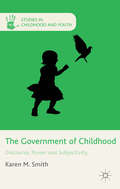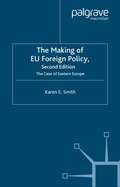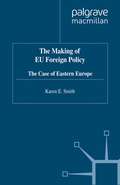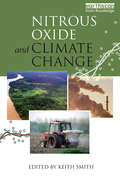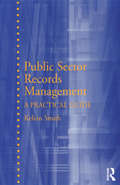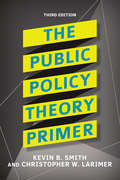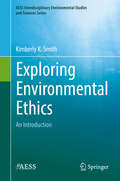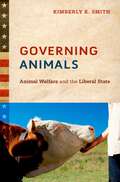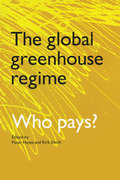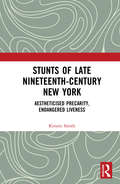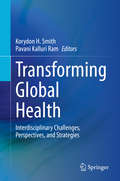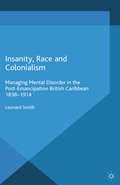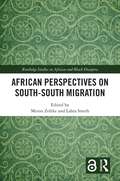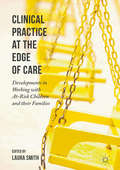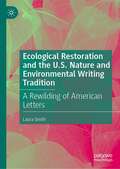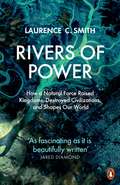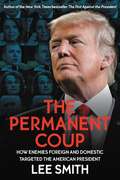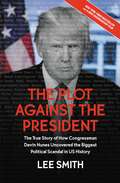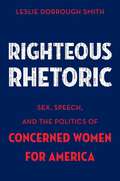- Table View
- List View
The Government of Childhood: Discourse, Power and Subjectivity (Studies in Childhood and Youth)
by K. SmithGrounded in the Foucauldian literature on governmentality and drawing on a broad range of disciplines, this book examines the government of childhood in the West from the early modern period to the present. The book deals with three key time-periods and examines shifts in the conceptualization and regulation of childhood and child-rearing.
The Making of EU Foreign Policy: The Case of Eastern Europe
by K. SmithThe Making of EU Foreign Policy argues that there has been a common European Union (EU) foreign policy towards six countries of Eastern Europe - Bulgaria, Czech Republic, Hungary, Poland, Romania, Slovakia - and analyzes why the EU has agreed to the policy. The objective of the EU's policy is to support the transformation of Eastern Europe and thus ensure security and stability. The most important instrument that the EU has used to reach this objective has been the prospect of enlargement.
The Making of EU Foreign Policy: The Case of Eastern Europe
by Karen E. SmithThis book argues that there has been a common European Union (EU) foreign policy towards six countries of Eastern Europe - Bulgaria, Czech Republic, Hungary, Poland, Romania, Slovakia - and analyses why the EU has agreed to the policy. The objective of the EU's policy is to support the transformation of Eastern Europe and thus ensure security and stability. The most important instrument that the EU has used to reach this objective has been the prospect of enlargement.
Nitrous Oxide and Climate Change
by Keith SmithNitrous oxide, N2O, is the third most important (in global warming terms) of the greenhouse gases, after carbon dioxide and methane. As this book describes, although it only comprises 320 parts per billion of the earth's atmosphere, it has a so-called Global Warming Potential nearly 300 times greater than that of carbon dioxide. N2O emissions are difficult to estimate, because they are predominantly biogenic in origin. The N2O is formed in soils and oceans throughout the world, by the microbial processes of nitrification and denitrification, that utilise the reactive N compounds ammonium and nitrate, respectively. These forms of nitrogen are released during the natural biogeochemical nitrogen cycle, but are also released by human activity. In fact, the quantity of these compounds entering the biosphere has virtually doubled since the beginning of the industrial age, and this increase has been matched by a corresponding increase in N2O emissions. The largest source is now agriculture, driven mainly by the use of synthetic nitrogen fertilisers. The other major diffuse source derives from release of NOx into the atmosphere from fossil fuel combustion and biomass burning, as well as ammonia from livestock manure. Some N2O also comes directly from combustion, and from two processes in the chemical industry: the production of nitric acid, and the production of adipic acid, used in nylon manufacture. Action is being taken to curb the industrial point-source emissions of N2O, but measures to limit or reduce agricultural emissions are inherently more difficult to devise. As we enter an era in which measures are being explored to reduce fossil fuel use and/or capture or sequester the CO2 emissions from the fuel, it is likely that the relative importance of N2O in the 'Kyoto basket' of greenhouse gases will increase, because comparable mitigation measures for N2O are inherently more difficult, and because expansion of the land area devoted to crops, to feed the increasing global population and to accommodate the current development of biofuels, is likely to lead to an increase in N fertiliser use, and thus N2O emission, worldwide. The aim of this book is to provide a synthesis of scientific information on the primary sources and sinks of nitrous oxide and an assessment of likely trends in atmospheric concentrations over the next century and the potential for mitigation measures.
Nitrous Oxide and Climate Change
by Keith SmithNitrous oxide, N2O, is the third most important (in global warming terms) of the greenhouse gases, after carbon dioxide and methane. As this book describes, although it only comprises 320 parts per billion of the earth's atmosphere, it has a so-called Global Warming Potential nearly 300 times greater than that of carbon dioxide. N2O emissions are difficult to estimate, because they are predominantly biogenic in origin. The N2O is formed in soils and oceans throughout the world, by the microbial processes of nitrification and denitrification, that utilise the reactive N compounds ammonium and nitrate, respectively. These forms of nitrogen are released during the natural biogeochemical nitrogen cycle, but are also released by human activity. In fact, the quantity of these compounds entering the biosphere has virtually doubled since the beginning of the industrial age, and this increase has been matched by a corresponding increase in N2O emissions. The largest source is now agriculture, driven mainly by the use of synthetic nitrogen fertilisers. The other major diffuse source derives from release of NOx into the atmosphere from fossil fuel combustion and biomass burning, as well as ammonia from livestock manure. Some N2O also comes directly from combustion, and from two processes in the chemical industry: the production of nitric acid, and the production of adipic acid, used in nylon manufacture. Action is being taken to curb the industrial point-source emissions of N2O, but measures to limit or reduce agricultural emissions are inherently more difficult to devise. As we enter an era in which measures are being explored to reduce fossil fuel use and/or capture or sequester the CO2 emissions from the fuel, it is likely that the relative importance of N2O in the 'Kyoto basket' of greenhouse gases will increase, because comparable mitigation measures for N2O are inherently more difficult, and because expansion of the land area devoted to crops, to feed the increasing global population and to accommodate the current development of biofuels, is likely to lead to an increase in N fertiliser use, and thus N2O emission, worldwide. The aim of this book is to provide a synthesis of scientific information on the primary sources and sinks of nitrous oxide and an assessment of likely trends in atmospheric concentrations over the next century and the potential for mitigation measures.
Public Sector Records Management: A Practical Guide
by Kelvin SmithRecords management has undergone significant change in recent years, owing to the introduction of freedom of information legislation as well as the development of e-government and e-business and the need to manage records effectively in both the private and public sector. There are very few purely practical texts for records managers and this book aims to fill that gap. The author has spent his entire career in public sector records management and has contributed to records management standards for governments around the world. The text is wholly practical and written at an accessible level. Although the author discusses legislation and examples from the UK, the book is relevant to public sector records management at an international level. It will be essential reading for professionals in record management posts as well as anyone who is responsible for record keeping as part of their operational duties.
Public Sector Records Management: A Practical Guide
by Kelvin SmithRecords management has undergone significant change in recent years, owing to the introduction of freedom of information legislation as well as the development of e-government and e-business and the need to manage records effectively in both the private and public sector. There are very few purely practical texts for records managers and this book aims to fill that gap. The author has spent his entire career in public sector records management and has contributed to records management standards for governments around the world. The text is wholly practical and written at an accessible level. Although the author discusses legislation and examples from the UK, the book is relevant to public sector records management at an international level. It will be essential reading for professionals in record management posts as well as anyone who is responsible for record keeping as part of their operational duties.
The Public Policy Theory Primer
by Kevin B. SmithPublic policy is a broad and interdisciplinary area of study and research in the field tends to reflect this. Yet for those teaching and studying public policy, the disjointed nature of the field can be confusing and cumbersome. This text provides a consistent and coherent framework for uniting the field of public policy. Authors Kevin B. Smith and Christopher W. Larimer offer an organized and comprehensive overview of the core questions and concepts, major theoretical frameworks, primary methodological approaches, and key controversies and debates in each subfield of policy studies from the policy process and policy analysis to program evaluation and policy implementation.?The third edition has been updated throughout to include the latest scholarship and approaches in the field, including new and expanded coverage of behavioral economics, the narrative policy framework, Fourth Generation implementation studies, the policy regime approach, field experiments, and the debate of program versus policy implementation studies. Now with an appendix of sample comprehensive exam questions, The Public Policy Theory Primer remains an indispensable text for the systematic study of public policy.
The Public Policy Theory Primer
by Kevin B. Smith Christopher LarimerPublic policy is a broad and interdisciplinary area of study and research in the field tends to reflect this. Yet for those teaching and studying public policy, the disjointed nature of the field can be confusing and cumbersome. This text provides a consistent and coherent framework for uniting the field of public policy. Authors Kevin B. Smith and Christopher W. Larimer offer an organized and comprehensive overview of the core questions and concepts, major theoretical frameworks, primary methodological approaches, and key controversies and debates in each subfield of policy studies from the policy process and policy analysis to program evaluation and policy implementation. The third edition has been updated throughout to include the latest scholarship and approaches in the field, including new and expanded coverage of behavioral economics, the narrative policy framework, Fourth Generation implementation studies, the policy regime approach, field experiments, and the debate of program versus policy implementation studies. Now with an appendix of sample comprehensive exam questions, The Public Policy Theory Primer remains an indispensable text for the systematic study of public policy.
Exploring Environmental Ethics: An Introduction (AESS Interdisciplinary Environmental Studies and Sciences Series)
by Kimberly K. SmithThis book is designed as a basic text for courses that are part of an interdisciplinary program in environmental studies. The intended reader is anyone who expects environmental stewardship to be an important part of his or her life, as a citizen, a policy maker, or an environmental management professional. In addition to discussing major issues in environmental ethics, it invites readers to think about how an ethicist's perspective differs from the perspectives encountered in other environmental studies courses. Additional topics covered include corporate social responsibility, ecological citizenship, property theory, and the concept of stewardship as a vocation.
Governing Animals: Animal Welfare and the Liberal State
by Kimberly K. SmithWhat is the role of government in protecting animal welfare? What principles should policy makers draw on as they try to balance animal welfare against human liberty? Much has been written in recent years on our moral duties towards animals, but scholars and activists alike have neglected the important question of how far the state may go to enforce those duties. Kimberly K. Smith fills that gap by exploring how liberal political principles apply to animal welfare policy. Focusing on animal welfare in the United States, Governing Animals begins with an account of the historical relationship between animals and the development of the American liberal welfare state. It then turns to the central theoretical argument: Some animals (most prominently pets and livestock) may be considered members of the liberal social contract. That conclusion justifies limited state intervention to defend their welfare - even when such intervention may harm human citizens. Taking the analysis further, the study examines whether citizens may enjoy property rights in animals, what those rights entail, how animals may be represented in our political and legal institutions, and what strategies for reform are most compatible with liberal principles. The book takes up several policy issues along the way, from public funding of animal rescue operations to the ethics of livestock production, animal sacrifice, and animal fighting. Beyond even these specific policy questions, this book asks what sort of liberalism is suitable for the challenges of the twenty-first century. Smith argues that investigating the political morality of our treatment of animals gives us insight into how to design practices and institutions that protect the most vulnerable members of our society, thus making of our shared world a more fitting home for both humans and the nonhumans to which we are so deeply connected.
Governing Animals: Animal Welfare and the Liberal State
by Kimberly K. SmithWhat is the role of government in protecting animal welfare? What principles should policy makers draw on as they try to balance animal welfare against human liberty? Much has been written in recent years on our moral duties towards animals, but scholars and activists alike have neglected the important question of how far the state may go to enforce those duties. Kimberly K. Smith fills that gap by exploring how liberal political principles apply to animal welfare policy. Focusing on animal welfare in the United States, Governing Animals begins with an account of the historical relationship between animals and the development of the American liberal welfare state. It then turns to the central theoretical argument: Some animals (most prominently pets and livestock) may be considered members of the liberal social contract. That conclusion justifies limited state intervention to defend their welfare - even when such intervention may harm human citizens. Taking the analysis further, the study examines whether citizens may enjoy property rights in animals, what those rights entail, how animals may be represented in our political and legal institutions, and what strategies for reform are most compatible with liberal principles. The book takes up several policy issues along the way, from public funding of animal rescue operations to the ethics of livestock production, animal sacrifice, and animal fighting. Beyond even these specific policy questions, this book asks what sort of liberalism is suitable for the challenges of the twenty-first century. Smith argues that investigating the political morality of our treatment of animals gives us insight into how to design practices and institutions that protect the most vulnerable members of our society, thus making of our shared world a more fitting home for both humans and the nonhumans to which we are so deeply connected.
The Global Greenhouse Regime: Who Pays?
by Kirk R. SmithEffective policies to prevent global warming and climatic change are urgently required by the world community. However, international negotiations on this issue repeatedly come up against the problems of allocating responsibility for the greenhouse effect, and bearing the costs of remedying the situation.;This volume offers a multidisciplinary response to the challenge. It presents the scientific, economic and political issues and goes on to describe the policy options available. The different ways of determining responsibility for greenhouse gases and calculating obligations to pay for hazards to the environment are analyzed. The contributors examine the implications for various countries, while a concluding chapter explores climatic change negotations - what is at stake, and for whom.
The Global Greenhouse Regime: Who Pays?
by Kirk R. SmithEffective policies to prevent global warming and climatic change are urgently required by the world community. However, international negotiations on this issue repeatedly come up against the problems of allocating responsibility for the greenhouse effect, and bearing the costs of remedying the situation.;This volume offers a multidisciplinary response to the challenge. It presents the scientific, economic and political issues and goes on to describe the policy options available. The different ways of determining responsibility for greenhouse gases and calculating obligations to pay for hazards to the environment are analyzed. The contributors examine the implications for various countries, while a concluding chapter explores climatic change negotations - what is at stake, and for whom.
Stunts of Late Nineteenth-Century New York: Aestheticised Precarity, Endangered Liveness
by Kirstin SmithStunts of Late Nineteenth- Century New York: Aestheticised Precarity, Endangered Liveness examines the emergence of stunts in the media, politics, sport and art of New York at the turn of the twentieth century. This book investigates stunts in sport, media and politics, demonstrating how these risky performances tapped into anxieties and fantasies concerning work, freedom, gendered/ raced/ classed bodies and the commodifi cation of human life. Its case studies examine bridge jumping, extreme walking contests, stunt journalists such as Nellie Bly, and cycling feats including Annie Londonderry’s round- the- world venture. Supported by extensive archival research and Performance Studies theorisations of precarity, liveness and surrogation, Smith theorises an under- examined form which is still prevalent in art, politics and commerce, to show what stunts reveal about value, risk and human life. Suitable for scholars and practitioners across a range of subjects, from Performance Studies to gender studies, to media studies, Stunts of Late Nineteenth- Century New York explores how stunts turned everyday precarity into a spectacle.
Stunts of Late Nineteenth-Century New York: Aestheticised Precarity, Endangered Liveness
by Kirstin SmithStunts of Late Nineteenth- Century New York: Aestheticised Precarity, Endangered Liveness examines the emergence of stunts in the media, politics, sport and art of New York at the turn of the twentieth century. This book investigates stunts in sport, media and politics, demonstrating how these risky performances tapped into anxieties and fantasies concerning work, freedom, gendered/ raced/ classed bodies and the commodifi cation of human life. Its case studies examine bridge jumping, extreme walking contests, stunt journalists such as Nellie Bly, and cycling feats including Annie Londonderry’s round- the- world venture. Supported by extensive archival research and Performance Studies theorisations of precarity, liveness and surrogation, Smith theorises an under- examined form which is still prevalent in art, politics and commerce, to show what stunts reveal about value, risk and human life. Suitable for scholars and practitioners across a range of subjects, from Performance Studies to gender studies, to media studies, Stunts of Late Nineteenth- Century New York explores how stunts turned everyday precarity into a spectacle.
Transforming Global Health: Interdisciplinary Challenges, Perspectives, and Strategies
by Korydon H. Smith Pavani Kalluri RamThis contributed volume motivates and educates across fields about the major challenges in global health and the interdisciplinary strategies for solving them. Once the purview of public health, medicine, and nursing, global health is now an interdisciplinary endeavor that relies on expertise from anthropology to urban planning, economics to political science, geography to engineering. Scholars and practitioners in the health sciences are seeking knowledge from a wider array of fields while, simultaneously, students across majors have a growing interest in humanitarian issues and are pursuing knowledge and skills for impacting well-being across geographic and disciplinary borders. Using a highly practical approach and illustrative case studies, each chapter of this edited volume frames a particular problem and illustrates how interdisciplinary problem-solving can address the greatest challenges in global health today. In doing so, each chapter spurs critical and creative thinking about emergent and future problems. Topics explored among the chapters include: Transforming health and well-being for refugees and their communitiesGoverning to deliver safe and affordable water The global crisis of antimicrobial resistanceLow-tech, high-impact interventions to prevent neonatal mortalityCommunicating taboo health subjectsAlternative housing delivery for slum upgrades Transforming Global Health: Interdisciplinary Challenges, Perspectives, and Strategies is a vital and timely compendium for any reader invested in improving global health equity. It will find an audience with researchers, practitioners, policymakers, and program implementers, as well as undergraduate and graduate students and faculty in the fields of global health, public health, and the health sciences.
Insanity, Race and Colonialism: Managing Mental Disorder in the Post-Emancipation British Caribbean, 1838-1914 (Cambridge Imperial and Post-Colonial Studies Series)
by L. SmithDespite emancipation from the evils of enslavement in 1838, most people of African origin in the British West Indian colonies continued to suffer serious material deprivation and racial oppression. This book examines the management and treatment of those who became insane, in the period until the Great War.
African Perspectives on South–South Migration (Routledge Studies on African and Black Diaspora)
by Lahra SmithThis book investigates the diverse and dynamic forms of migration within Africa. Centring themes of agency, resource flows, and transnational networks, the book examines the enduring appeal of the Global South as a place of origin, transit, and destination.Popular media, government pronouncements, and much of the global research discourse continue to be oriented towards migration from the Global South to the Global North, despite the fact that the vast majority of migration is South-South. This book moves beyond these mischaracterisations and instead distinctly focuses on the agency of African migrants and the creative strategies they employ while planning their routes within and across the African continent. Case studies explore the flow of resources such as people, money, skills, and knowledge throughout the continent, while also casting a light on the lived experiences of migrants as they negotiate their sometimes precarious and vulnerable positions. Underpinned by intensive empirical studies, this book challenges prevailing narratives and provides a new way of thinking about South-South Migration.Composed by a majority of scholars from the Global South, the book will be crucial reading for researchers, students, and policy makers with a focus on South-South Migration, Migration and Inequalities, Migration and Development, and Refugee and Humanitarian Studies.
Clinical Practice at the Edge of Care: Developments in Working with At-Risk Children and their Families
by Laura SmithThis book brings together psychological and psychotherapeutic contributions in clinical practice with at-risk children and their families. Chapters by experts working in a range of edge-of-care settings give an essential account of real-world clinical challenges and dilemmas; whilst drawing on relevant theory and the growing evidence base for edge of care work with children and families. This title will be of interest to both clinical and social work practitioners, those commissioning and developing best practice in edge of care services, scholars and students of Clinical Psychology, Systemic Psychotherapy and related disciplines.
Ecological Restoration and the U.S. Nature and Environmental Writing Tradition: A Rewilding of American Letters
by Laura SmithThis book presents a critical history of the intersections between American environmental literature and ecological restoration policy and practice. Through a storying—restorying—restoring framework, this book explores how entanglements between writers and places have produced literary interventions in restoration politics. The book considers the ways literary landscapes are politicized by writers themselves, and by conservationists, activists, policymakers, and others, in defense of U.S. public lands and the idea of wilderness. The book profiles five environmental writers and examines how their writings on nature, wildness, wilderness, conservation, preservation, and restoration have variously inspired and been translated into ecological restoration programs and campaigns by environmental organizations. The featured authors are Henry David Thoreau (1817–1862) at Walden Pond, John Muir (1838–1914) in Yosemite National Park, Aldo Leopold (1887–1948) at his family’s Wisconsin sand farm, Marjory Stoneman Douglas (1890–1998) in the Everglades, and Edward Abbey (1927–1989) in Glen Canyon. This book combines environmental history, literature, biography, philosophy, and politics in a commentary on considering (and developing) environmental literature’s place in conversations on restoration ecology, ecological restoration, and rewilding.
Rivers of Power: How a Natural Force Raised Kingdoms, Destroyed Civilizations, and Shapes Our World
by Laurence C. Smith'As fascinating as it is beautifully written' JARED DIAMOND, Pulitzer Prize-winning author of Guns, Germs and SteelRivers, more than any road, technology or political event, have shaped the course of civilization. Rivers have opened frontiers, defined borders, supported trade, generated energy and fed billions. Most of our greatest cities stand on river banks or deltas, and our quest for mastery has spurred staggering advances in engineering, science and law. Rivers and their topographic divides have shaped the territories of nations and the migration of peoples, and yet - as their resources become ever more precious - can foster cooperation even among enemy states. And even as they become increasingly domesticated, they remain a formidable global force: these vast arterial powers promote life but are capable of destroying everything in their path.From ancient Egypt to our growing contemporary metropolises, Rivers of Power reveals why rivers matter so profoundly to human civilization, and how they continue to be indispensable to our societies and wellbeing.'Takes readers on a tour of the world's great rivers - past, present and future. The result is fascinating, eye-opening, sometimes alarming, and ultimately inspiring' Elizabeth Kolbert, Pulitzer Prize-winning author of The Sixth Extinction'A tour de force ... From Herodotus musing on the Nile to the dam makers of modern China, this is their story' Fred Pearce, author of When the Rivers Run Dry
The Permanent Coup: How Enemies Foreign and Domestic Targeted the American President
by Lee SmithFrom the phony Russia collusion narrative to the coordinated riots laying waste to US cities, it's the same ongoing operation orchestrated by the left and targeting not just President Trump but hundreds of millions of Americans who revere their country and what it stands for. For the first time, crusading investigative journalist Lee Smith reveals who was responsible and the never before known involvement of Barack Obama, Joe Biden, and senior military officials who engineered a coup against a sitting president. Beginning in late 2015, political operatives, intelligence officials, and the press pushed a conspiracy theory about Trump-he was a Russian asset and spied on his campaign and his presidency in order to undo an election.Because the ultimate goal of the anti-Trump operation is not simply to topple the president but rather to change the character and constitution of the country, the Deep State's machinations didn't stop even after Trump was cleared of charges of "colluding" with Moscow. Their efforts became even more fierce, more desperate, and more divisive, threatening to scar America permanently. In their zeal to bring down President Trump, Deep State conspirators had unwittingly revealed the origins of the anti-Trump operation and exposed corruption at the very highest levels of the Democratic party-including former Vice President Biden and his boss, Barack Obama.Lee Smith brings to this story the same incisive reporting and commentary that distinguished his runaway bestseller, The Plot Against the President. His investigation, identifying crimes and abuses committed by senior US officials, was later confirmed by a major Department of Justice report.For The Permanent Coup, Smith again enjoys unrivaled and exclusive access to the main players defending America and uncovering Deep State crimes-including Congressman Devin Nunes and the president's personal lawyer, Rudy Giuliani.
The Plot Against the President: The True Story of How Congressman Devin Nunes Uncovered the Biggest Political Scandal in U.S. History
by Lee SmithInvestigative journalist Lee Smith uses his unprecedented access to Congressman Devin Nunes, former head of the House Intelligence Committee, to expose the deep state operation against the president--and the American people. Investigative journalist Lee Smith's The Plot Against the President tells the story of how Congressman Devin Nunes uncovered the operation to bring down the commander-in-chief. While popular opinion holds that Russia subverted democratic processes during the 2016 elections, the real damage was done not by Moscow or any other foreign actor. Rather, this was a slow-moving coup engineered by a coterie of the American elite, the "deep state," targeting not only the president, but also the rest of the country. The plot officially began July 31, 2016 with the counterintelligence investigation that the FBI opened to probe Russian infiltration of Donald Trump's presidential campaign. But the bureau never followed any Russians. In fact, it was an operation to sabotage Trump, the candidate, then president-elect, and finally the presidency. The conspirators included political operatives, law enforcement and intelligence officials, and the press.The plot was uncovered by Nunes, chairman of the House Intelligence Committee, and his investigative team. They understood that the target of the operation wasn't just Trump, but rather the institutions that sustain our republic. A country where operatives use the intelligence and security services to protect their privileges by spying on Americans, coordinating with the press, and using extra-constitutional means to undermine an election then undo a presidency is more like the third world than the republic envisioned by the founding fathers. Without Nunes and his team, the plot against the president -- and against the country -- never would have been revealed. Told from the perspective of Nunes and his crack investigators -- men and women who banded together to do the right thing at a crucial moment for our democracy -- the story of the biggest political scandal in a generation reads like a great detective novel, feels like a classic cowboy movie. The congressman from the cattle capital of California really did fight corruption in Washington. Devin Nunes took on the "deep state."
Righteous Rhetoric: Sex, Speech, and the Politics of Concerned Women for America (AAR Academy Series)
by Leslie Dorrough SmithScholars who study the Christian Right often claim that the movement's distinction lies in its moral absolutism and religious fervor. Through a detailed study of the sexually-charged rhetoric of one of America's largest conservative women's organizations, Concerned Women for America (CWA), Righteous Rhetoric argues that the absolute platforms for which CWA is known are not the linchpin of its political power. Rather, such absolutes are the byproduct of a more fundamental rhetorical process called "chaos rhetoric," a type of speech designed to create a heightened sense of social chaos and threat. In response, CWA is able to flexibly counter this negative emotion by crafting a positive identity for itself, shifting in ways that are politically advantageous in the tumultuous cultural contests that occur over sex, gender, and reproduction. However powerful this technique may prove, Righteous Rhetoric demonstrates that chaos rhetoric is not unique to CWA, but is a ubiquitous tactic used by almost all groups in the fight for social dominance. Where CWA and the Christian Right's true source of distinction lies is thus not in unique theologies or political tactics, but in the ability to fuse its own identity with America's most beloved symbols in such a way that its own existence is rendered inseparable from the nation's very survival.
